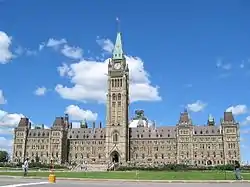Unemployment and Farm Relief Act
The Unemployment and Farm Relief Act - An Act to confer certain powers upon the Governor in Council in respect to unemployment and farm relief, and the maintenance of peace, order and good government in Canada, (French: Loi remédiant au chômage et aidant à l’agriculture) (the Act) was introduced by Prime Minister R.B. Bennett,[2] and enacted in July 1931 by the Parliament of Canada, enabling public works projects to be set up in Canada's national parks during the Great Depression. This legislation followed the Unemployment Relief Act, passed in 1930, which provided grants for municipal public works projects.
| Unemployment and Farm Relief Act | |
|---|---|
 | |
| Parliament of Canada | |
| |
| Citation | Unemployment and Farm Relief Act[1] |
| Enacted by | Parliament of Canada |
| Assented to | August 3, 1931 |
The Act provided funds to municipalities and the provinces for road building projects, as well as funds set aside for projects in the national parks.[3] The Act's Section 4:
"The Governor in Council shall have full power to make all such orders and regulations as may be deemed necessary or desirable for relieving distress, providing employment and, within the competence of Parliament, maintaining peace, order and good government throughout Canada."[1]
also enabled the authorities to combat unrest based on "pernicious" revolutionary doctrines, such as were espoused by the Communist Party of Canada.[2][4]
The Act had an expiry date of March 1, 1932.[5]
References
- "Acts of the Parliament of Canada (17th Parliament 1st Session, Chapter 1 - 3 & 2nd Session, Chapter 1-61), 1931". pp. 429–430.
- Wells 2016, p. 162
- Bryce, R. (1986). Maturing in Hard Times: Canada's Department of Finance Through the Great Depression. McGill-Queen's Press.
- Creighton 1970, p. 201
- Acts of the Parliament of Canada (17th Parliament 1st Session, Chapter 1 - 3 & 2nd Session, Chapter 1-61), 1931, p. 430, Parliament of Canada
Bibliography
- Wells, Mike; Fellows, Nick (2016). The Great Depression and the Americas (mid 1920s–1939). Cambridge University Press.